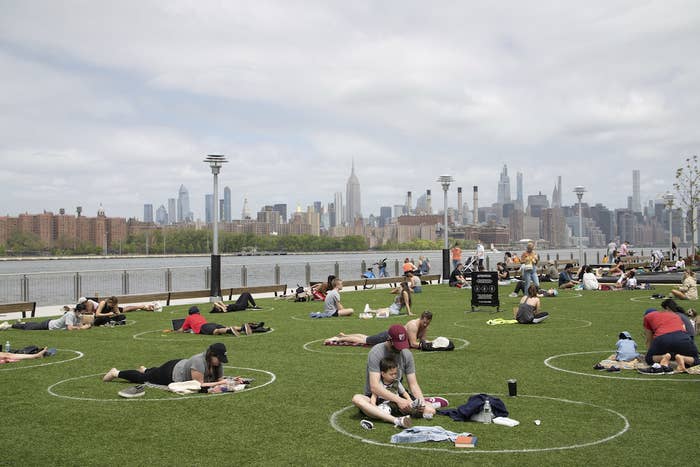
BuzzFeed News has reporters across five continents bringing you trustworthy stories about the impact of the coronavirus. To help keep this news free, become a member and sign up for our newsletter, Outbreak Today.
New York Gov. Andrew Cuomo has permitted the nonessential gathering of up to 10 people for "any lawful reason" in the state as the daily coronavirus death toll dropped under 100 for the first time since March.
Issued Friday night, the executive order, which reminds people to continue adhering to "the social distancing protocols and cleaning and disinfection protocols required by the Department of Health," comes as the country heads into Memorial Day weekend.
A previous order Thursday allowed for gatherings of up to 10 people for religious services or Memorial Day celebrations, but it led to a lawsuit from the New York Civil Liberties Union on the grounds that protests and other gatherings protected by the First Amendment were still banned.
"The right to protest and exercise free speech is the foundation of all our other liberties, and during a crisis is exactly when we need to be most vigilant about protecting it," the union said in a statement. "Health experts, elected officials, and police officers all agree that people can be outside safely while practicing social distancing, and it's critical that lawmakers create guidelines and direct law enforcement uniformly."
Cuomo said at his daily briefing Saturday that he was not aware of the lawsuit before issuing the order.
"You can have a safe gathering of 10 people," he told reporters. "Is it worth the risk? Two people is a risk. Five people is a risk. Ten people is a risk. Any one of those people could be infected."
The order was condemned by New York City Councilmember Mark D. Levine, who called it "shocking" and urged people "not to interpret this as advice to change their behavior" in tweets Friday night.
New York City has 194,667 confirmed coronavirus cases to date, and more than 16,000 people have died.
This shocking order, forced by a lawsuit, changes nothing about the risks associated with group gatherings--especially those held indoors. We need the public to continue to be smart and use judgement about the risks of this virus, regardless of what the court has forced on us. https://t.co/UexIsXWa8w
BREAKING: New York allows all gatherings of up to 10 people for any purpose. This was not a decision made by health professionals. It was forced by a lawsuit. ** No one should interpret this as advice to change their behavior.** https://t.co/wJo2GGElPk
Only a few parts of New York state have been cleared for reopening so far. The state's COVID-19 daily death toll has fallen below 100 for the first time since March, Cuomo said Saturday, and cases and hospitalizations continue to decline.
New York reported a total of 4,642 patients hospitalized with COVID-19 and 1,502 patients in the ICU as of Friday, compared to 18,825 patients hospitalized and 5,156 in the ICU at the state's peak in mid-April.
This decrease is key to understanding the reasoning behind Cuomo's order, said Dr. Amesh Adalja, a physician and senior scholar at Johns Hopkins University who focuses on emerging infectious disease and pandemic preparedness.
We lost 84 New Yorkers to COVID-19 yesterday. By any normal standard this is a hideous number. But we are thankful this number has fallen below 100 for the first time since late March.
"When you look at the trajectory of New York state, I do think that this type of order is justified," Adalja told BuzzFeed News. "The only reason for the government order of social distancing was to prevent the hospital capacity from being compromised. Now it becomes an individual decision."
Adalja said allowing people to gather in groups of up to 10 people isn't by any means an indication that people should stop being cautious about the virus, but that the state and the healthcare system is now more equipped to help those who get sick.
Realistically, some people will choose to gather regardless of government guidelines, so allowing people to congregate legally, Adalja said, will hopefully prevent them from doing so in an unsafe manner.
"If you say that this is permissive, and have public health messaging to emphasize it, it's better than having these things happen underground," he said. "Then people are worried about coming forward saying, 'I was at this party and got sick,' and it makes it much harder."
The safety of larger gatherings ultimately comes down to the diligence of those participating, Dr. Jared Baeten, a University of Washington professor of global health and infectious diseases, told BuzzFeed News.
"You can have a 10-person gathering where you could try and be completely safe, and you can have a 10-person gathering that would be set up for 100 people getting infected," Baeten said. "Ten-person gatherings are particularly bad if you go from one to another to another, especially on a holiday weekend."
If people live in a place where gatherings are permitted, the safest approach is to form a social "bubble" with friends or extended family.
"If it’s 10 people who only have contact with each other, then it’s a much lower risk," Baeten said. "If you’re interacting with the same people, then if there’s transmission it’s contained within that bubble."
